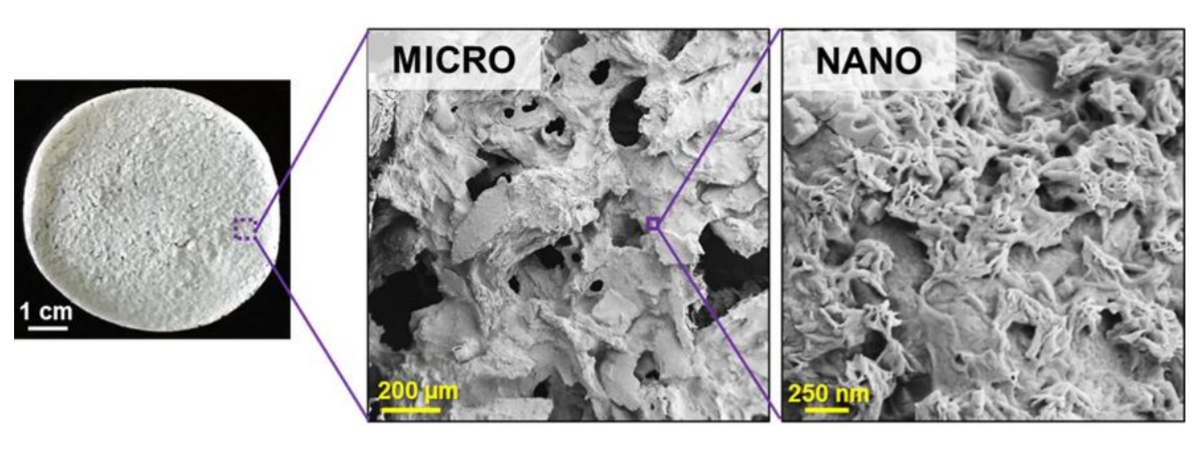Navigating through the landscape of bioprinting, 2023 unfolded as a year where targeted investments significantly nurtured this specialized field. The ripples of these investments indicate a maturing industry poised for growth. This year’s investment trend in bioprinting was marked by a series of strategic moves aimed at deepening the potential of bioprinting in medical applications.
The investments in 2023 primarily came from public or government sectors, with notable contributions from private entities. A common thread among these investments is their focus on innovative applications in healthcare, aiming to bridge the gap between advanced research and practical medical solutions. From ambitious projects aiming to revolutionize organ transplantation to more focused studies enhancing specific medical treatments, each funding initiative reflected a concerted effort to harness bioprinting’s potential for real-world impact.
December: NIH Diversity Grant
Towards the end of the year, Pennsylvania State University‘s (Penn State) Bio-Soft Materials Laboratory (B-SMaL) received a boost for research on bioprinting blood vessel networks through a National Institutes of Health (NIH) diversity grant of $293,016. This funding, supplementing a larger $3 million NIH grant, bolsters the role of bioprinting in understanding vascular diseases. Angie Castro, a doctoral student in chemical engineering, leads the work under the guidance of B-SMaL director Amir Sheikhi. Castro’s work aims to create organized blood vessel structures in tissue, which could lead to better in vitro drug testing and more effective clinical treatments.
 Amir Sheikhi and Angie Castro will lead the four-year, $3M National Institutes of Health grant as principal investigator. Image courtesy of Kelby Hochreither/Penn State.
Amir Sheikhi and Angie Castro will lead the four-year, $3M National Institutes of Health grant as principal investigator. Image courtesy of Kelby Hochreither/Penn State.November: RCSI’s POLINA Project
In one of the year’s last notable investments, the Royal College of Surgeons in Ireland (RCSI) received €2.9 million for the POLINA project, backed by the European Innovation Council. Led by RCSI Professor Andreas Heise, the project seeks to develop new materials and technologies for medical applications, with a particular focus on enhancing the precision in creating 3D biostructures and devices. The project plans to use light-sensitive polyamino acid (PAA) combined with advanced 3D bioprinting, drawing inspiration from the microelectronics industry to achieve this goal.
The POLINA project begins in January 2024 and will target the development of medical devices and materials more compatible with human cells. One of its key goals is to demonstrate the technology’s potential in treating lung diseases, including creating cell surface models and tracheal implants. This project represents a significant step in advancing bioprinting technology, potentially leading to more effective and affordable medical devices and broadening the scope for innovative technologies in healthcare.
September: Stanford University’s Heart Bioprinting
Stanford University‘s groundbreaking project to bioprint a functioning human heart, funded with $26.3 million from the Advanced Research Projects Agency for Health (ARPA-H), represents one of the year’s most ambitious bioprinting ventures. This project not only showcases the potential of bioprinting in complex organ fabrication but also marks a significant step towards patient-specific treatments, revolutionizing the field of organ transplantation.
July: 3D BioFibR Funding
Canadian company 3D BioFibR raised over $3.52 million to bring its bioprinted collagen fiber products to market. The brand’s new offerings, μCollaFibR and CollaFibR 3D scaffold, are produced using a proprietary, fully automated dry-spinning process capable of commercially producing high-quality, diameter-controlled collagen fibers.
This investment highlights a shift towards commercializing bioprinting applications, particularly in tissue engineering. The funding will advance the company’s capabilities in manufacturing high-quality collagen fibers, highlighting the evolving landscape of bioprinting as it progresses from research to market-ready solutions.
July: Penn State’s High-Speed Bioprinting Project
Another bioprinting initiative at Penn State was supported by over $2 million from the NIH. This project focuses on developing technology for rapid bioprinting of bones, tracheas, and organs and represents a step towards more efficient tissue fabrication.
“This will be a platform technology, which can be used for implantation, inserting tissue directly into the body, or it can bioprint model organs for research like drug development and disease modeling,” explains project leader Ibrahim T. Ozbolat, Professor of Engineering Science and Mechanics, Biomedical Engineering, and Neurosurgery at Penn State.
Once fully developed, this technology can be applied to fabricating various human tissues, including cardiac or lung tissue, skin, or even bone. This technology could rapidly repair bone, even in sensitive places like the skull.
June: OHSU Cancer Research Grant
The OHSU Knight Cancer Institute received a $1 million grant to enhance cancer research through 3D bioprinting. The grant is equipping and expanding the new Precision Biofabrication Hub at OHSU, where researchers take small samples of human cells from organ tissues to reproduce organs, cancerous tumors, and bone material using 3D bioprinters and other advanced engineering, opening new avenues for understanding and treating cancer.
“The mission of the Cancer Institute is to end cancer as we know it,” said Luiz Bertassoni, Director of the Precision Biofabrication Hub.
April: PRISM-LT Project
Funded with €2.3 million from the European Innovation Council, the PRInted Symbiotic Materials as a dynamic platform for Living Tissues production (PRISM-LT) project is pioneering an adaptable platform for 3D bioprinting living tissues with applications that span biomedical and food technology sectors. This innovative project, part of a concerted effort to advance Engineered Living Materials, aims to create living tissues with dynamic functionalities and predictable shapes inspired by natural tissue development. PRISM-LT focuses on designing heterogeneous, 3D printable living materials capable of self-assembly into complex tissues, ranging from sub-millimeter to centimeter scales. A novel aspect of the project is the development of a tunable bioink that promotes a symbiotic relationship between stem cells and microorganisms, aiding in stem cell differentiation. Key applications include creating organoid models for preclinical drug research and engineering synthetic meat that replicates natural marbling, texture, and nutritional values.
The project includes the University of Glasgow, Chalmers University of Technology, Radboud University, and the University of Aveiro, as well as non-profit IN Society and 3D bioprinting pioneer Cellink, overall representing Italy, Portugal, Sweden, the Netherlands, and the United Kingdom.
 3D rendering of a Cells-Microorganisms Structure. Image courtesy of IN society.
3D rendering of a Cells-Microorganisms Structure. Image courtesy of IN society.April: Aspect Biosystems and Novo Nordisk Partnership
Aspect Biosystems‘ partnership with Novo Nordisk, announced in April, brought a new dimension to bioprinting investments. Combining Aspect’s bioprinting technology with Novo Nordisk’s expertise in cell therapy, this collaboration, bolstered by a significant financial agreement, focuses on creating bioprinted tissue therapeutics for diabetes and obesity. This partnership represents a fusion of technological expertise and demonstrates the private sector’s increasing interest in bioprinting’s therapeutic potential.
February: Dimension Inx Series A Round
In early 2023, Dimension Inx made a significant leap with a $12 million Series A funding round to accelerate the development and commercialization of its regenerative therapeutics. Known for its 3D printed bone graft product CMFlex, the company is a promising example of how bioprinting can transition from research labs to clinical applications. Marking a major milestone, the U.S. Food and Drug Administration‘s (FDA)-approved CMFlex has been successfully used in jaw surgeries in the U.S. and Germany. The 3D printed regenerative bone graft, designed for maxillofacial, mandibular, and dental bone defects, is manufactured using 3D bioplotters from Desktop Health. CMFlex combines hydroxyapatite and biodegradable PLG polymer in a hyperelastic bone composite, demonstrating the practical application and clinical potential of bioprinting technologies.
 A representative example of a small sheet of Tissue Paper derived from ovarian tissue, highlighting its unique micro- and nano-porosity and texture. Image courtesy of Dimension Inx.
A representative example of a small sheet of Tissue Paper derived from ovarian tissue, highlighting its unique micro- and nano-porosity and texture. Image courtesy of Dimension Inx.The investments in bioprinting in 2023 reflect a sector steadily moving into the developmental and experimental stages. Although the journey from laboratory breakthroughs to widespread clinical applications is complex and incremental, this technology continues to show potential in medical solutions.
Subscribe to Our Email Newsletter
Stay up-to-date on all the latest news from the 3D printing industry and receive information and offers from third party vendors.
You May Also Like
Gorilla Sports GE’s First 3D Printed Titanium Cast
How do you help a gorilla with a broken arm? Sounds like the start of a bad joke a zookeeper might tell, but it’s an actual dilemma recently faced by...
Nylon 3D Printed Parts Made More Functional with Coatings & Colors
Parts 3D printed from polyamide (PA, Nylon) 12 using powder bed fusion (PBF) are a mainstay in the additive manufacturing (AM) industry. While post-finishing processes have improved the porosity of...
$25M to Back Sintavia’s Largest Expansion of Metal 3D Printing Capacity Since 2019
Sintavia, the digital manufacturing company specializing in mission-critical parts for strategic sectors, announced a $25 million investment to increase its production capacity, the largest expansion to its operations since 2019....
Velo3D Initiates Public Offering in a Bid to Strengthen Financial Foundations and Drive Future Growth
Velo3D (NYSE: VLD) has been among a number of publicly traded 3D printing firms that have attempted to weather the current macroeconomic climate. After posting a challenging financial report for 2023,...
































